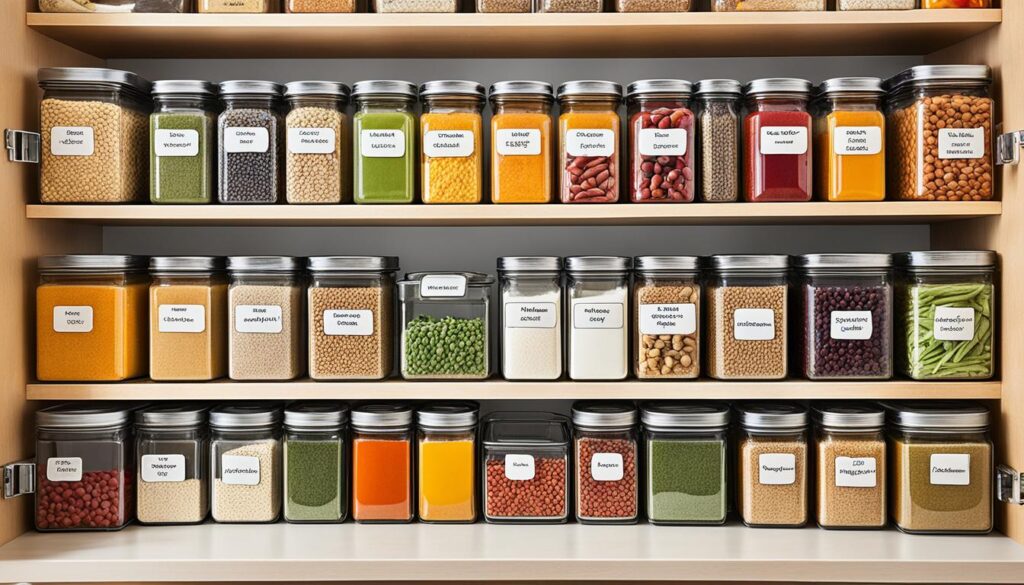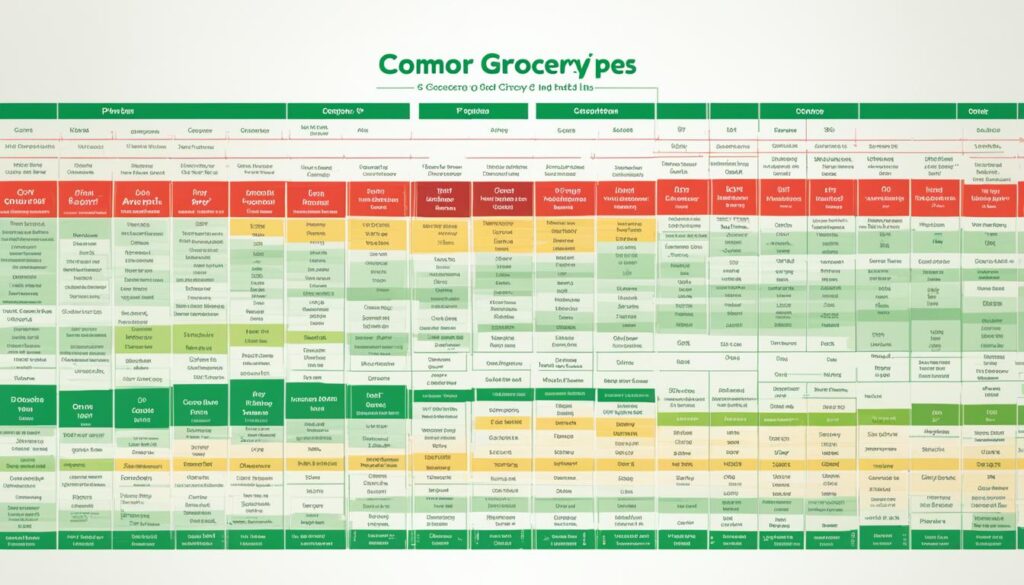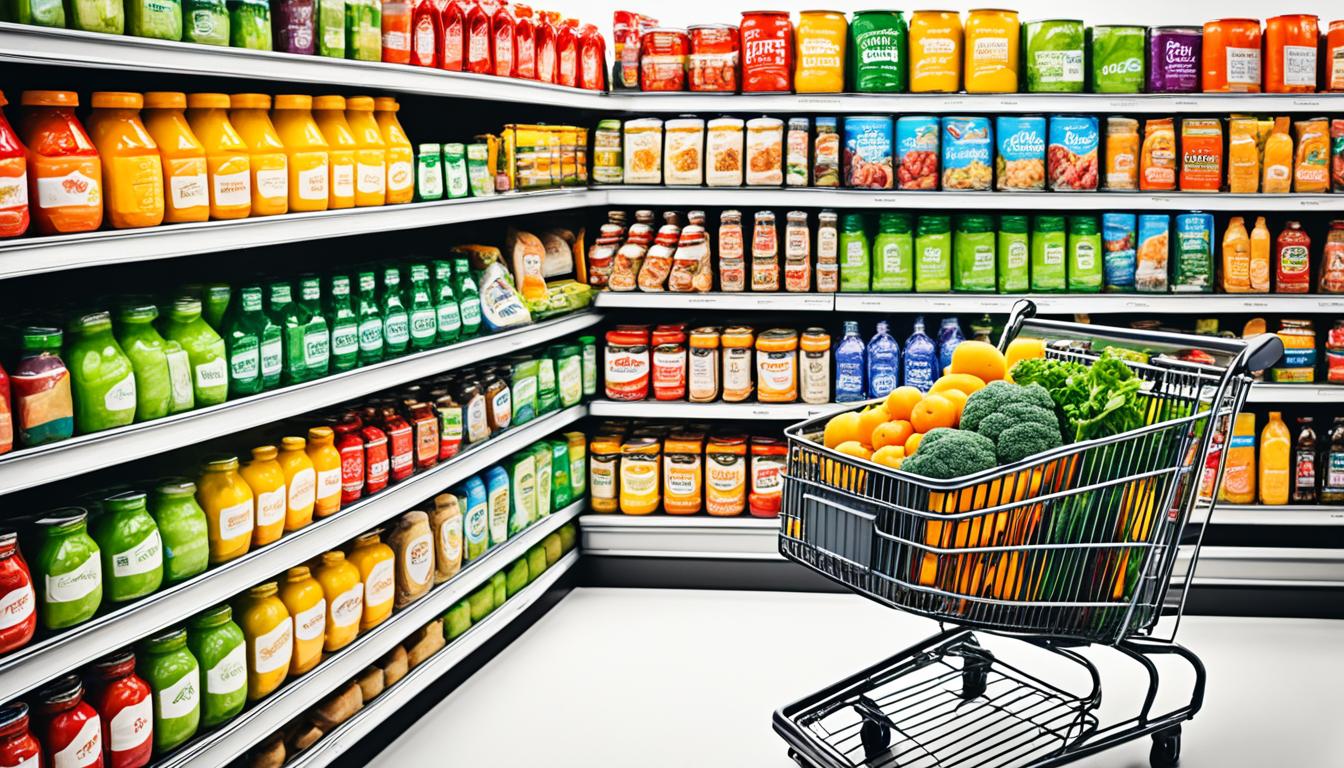“As an Amazon Associate I earn from qualifying purchases.” .
Imagine saving money every time you visit the grocery store. You end up with a cart full of healthy food. Creating a budget grocery list is an art for smart shoppers. It’s about finding good deals and making great meals. But balancing savings and a healthy diet can be tricky. How can we save without sacrificing taste or nutrition?
We are on a journey to balance tight budgets with delicious food. Our tips will help you become a wise and happy grocery shopper. Let’s make your kitchen a place for tasty, affordable food without needing coupons.
Key Takeaways
- Mastering the elements of a practical budget grocery list can save you money while enhancing meal quality.
- Utilize strategies to prioritize both nutrition and savings, proving that grocery list essentials don’t have to be expensive.
- Discover how savvy shoppers navigate promotional aisles and seasonal produce to secure mouthwatering deals.
- Learn the significance of meal planning and how you can harness it for both convenient and affordable shopping.
- Identify products that offer the best value for your dollar, ensuring every purchase counts towards saving money on groceries.
Mastering the Art of the Budget Grocery List
Imagine making your weekly shopping a mix of nutrition and savings. It starts with smart planning and smart choices. This leads to the perfect budget grocery list. Let’s explore how to build a frugal pantry and the keys to grocery list optimization.
The Foundation of a Frugal Pantry
Starting with a good pantry is key to great meals. Make sure to have non-perishables like whole grains, dried beans, and canned tomatoes. Buying these items in large quantities saves money and builds your frugal pantry. A full pantry is your first step toward affordable, gourmet cooking.
Optimizing Your List for Nutrition and Savings
Making a smart grocery list helps save money. Add frozen fruits and veggies to get nutrients without spending a lot. Planning your meals every week can also save money and organize your food plans.
Use weekly ads and specials to make your meals interesting and save money. Don’t shop hungry to avoid buying things you don’t need. Shopping hungry makes you buy on a whim.
Finally, sign up for your store’s reward programs for special deals. These deals add extra savings to your budget. They’re little bonuses in your budget-saving plan.
| Strategy | Benefit | Example |
|---|---|---|
| Bulk Buying | Long-term Savings | Rice, Pasta |
| Frozen Goods | Cost Savings | Frozen Berries, Spinach |
| Rewards Programs | Exclusive Deals | Member-only Discounts |
| Meal Planning | Reduced Waste & Spending | Weekly Meal Prep |
| Ad Awareness | Discounted Shopping | Weekly Specials |
This ends our guide to a budget-friendly shopping list. Follow these tips for a shopping experience that’s good for your wallet and your stomach. Head out with your list, and create a masterpiece of nutrition and savings.
Strategies for Affordable Meal Planning
Looking to save money without cutting down on meal quality? Jump into affordable meal planning with excitement. By mastering a few meal prep tips and strategies, you’ll see that making budget-friendly meals is easy and fun!
Start with the weekly sales flyers. They’re jam-packed with deals, either in your mail or on your store’s app. Plan your meals based on what’s on sale to save money. For example, affordable bell peppers can be cut and frozen for various meals. Using sales to guide your meal planning makes it an affordable and adventurous journey!
Then, buy staples in bulk when they’re cheap. Rice and beans are inexpensive and versatile. Shopping at warehouse stores can reduce costs even more. These foods are basics of affordable meal planning, leading to dishes from all over the globe.
Don’t forget about the freezer, perfect for storing ready-made meals. A large dish of Stouffer’s Macaroni & Cheese, for instance, is less than $10. It’s a cost-effective and easy meal for when you’re short on time or money.
Finally, consider paying with cash. It might feel traditional, but it helps stick to your budget. When you run out of cash, that means no more spending. This simple method can surprisingly help you save.
| Strategy | Why It Works | Estimated Savings |
|---|---|---|
| Bulk Buying | Reduced unit pricing, less packaging | Varies by item and store |
| Planning with Sales | Leverages discounts, avoids unnecessary buys | 10%-30% on planned items |
| Frozen Prepared Meals | Cost-efficient, saves time | Under $10 per meal |
| Paying with Cash | Limits spending, curbs impulses | Flexible, subject to budget |
Low Cost Pantry Essentials: The Building Blocks of Thrifty Meal Prep
Starting your thrifty meal prep journey isn’t just about cooking. It begins with stocking your pantry right. Low cost pantry essentials are key to avoiding food waste and staying within budget. Wondering how to make sure your basics help rather than stress you? Read on!
Stocking Your Staples Wisely
Think of your pantry as your kitchen’s savings account. It requires smart choices. Diversity and versatility are important. Aim for a wide range of grains, legumes, oils, and seasonings. These should be items you can turn into different meals, offering budget-friendly taste adventures nightly.

Extending Shelf-Life and Maximizing Value
Did you know extending shelf-life also means maximizing value? Items like chickpeas, rice, and vinegar last longer when stored properly. The secret? Keep them cool, dark, and sealed. Don’t sacrifice a seal for aesthetics with pasta; it invites staleness.
Let’s look at some top picks for an affordable, long-lasting pantry:
| Staple | Cost Efficiency | Shelf-Life | Meal Prep Versatility |
|---|---|---|---|
| Dried Beans | High | Up to 2 years | Chilis, soups, salads |
| Whole Grains | High | 1 year | Stir-fries, pilafs, porridge |
| Nuts and Seeds | Moderate | 6 months to 1 year | Snacks, toppings, baking |
| Generic brand Spices | High | 2 to 3 years | Flavoring for any dish |
| Canned Tomatoes | High | Up to 18 months | Sauces, soups, casseroles |
And there you go! With these low cost pantry essentials, you’re ready to cook deliciously on a budget. Embrace thrifty meal prep confidently. It’s about enjoying the journey of smart shopping as much as saving money.
Economic Grocery Budget: Balancing Quality and Cost
Ever felt puzzled by how to mesh quality and cost in your groceries? You’re not the only one. It’s like walking a tightrope, trying to pick budget-friendly options that still let you eat well. With a bit of smart planning and care, your economic grocery budget can deliver meals that are kind to your bank account and your taste buds. Ready to master the art of savvy shopping? Here are some critical grocery shopping tips to follow.
Grocery Shopping Tips:
- Spot the “loss leaders” – items sold at a loss to attract customers. Build your menu with these deals.
- Don’t overlook store brands; they’re often as good as name brands but cheaper.
- Make the most of apps and coupons for smart savings on quality products.
- Embrace seasonal produce for its lower cost and better taste.
- Buying in bulk is smart if you avoid wasting food.
| Regular Purchase | Cost-Effective Alternative | Estimated Savings |
|---|---|---|
| Brand-name cereal | Store-brand cereal | $1 – $2 per box |
| Fresh out-of-season berries | Frozen or in-season fruit | $2 – $4 per pound |
| Premium cuts of meat | Less expensive cuts or plant-based proteins | $3 – $5 per pound |
| Pre-packaged salads | Bulk greens and mix-ins | $2 – $3 per meal |
| Bottled water | Filtered tap water | Up to $15 per 24-pack |
Smart shoppers know that high prices don’t always mean better groceries. It’s about making wise choices, not just chasing the cheapest options. Follow these tips and keep an eye out for budget-friendly options. Soon, you’ll fill your cart with great value.

Thrifty Shopping Guide: Navigating the Aisles Like a Pro
Get ready for your next trip to the grocery store. Every aisle offers a chance to save money without breaking the bank. Being a savvy shopper is more than just cutting costs—it means shopping smart. You’ve made saving money fun, and now it’s time to take it to the next level!
Wise Choices: Fresh, Frozen, or Canned?
Before you create that budget-friendly meal, you need to decide: fresh, frozen, or canned? Each option has its benefits and downsides. Let’s look into them, shall we?
- Fresh: The taste of ripe, juicy tomatoes or crunchy carrots is unmatched. Choose fresh for immediate use. They’re tastier and often cheaper when in season.
- Frozen: Frozen fruits and vegetables are picked and frozen quickly to keep their goodness. They’re a good deal and last longer. Stock up on these freezer gems!
- Canned: Canned goods are great for your wallet and last ages. But beware of extra salt or sugar—they’re not so great for your health.
Each trip to the store is your chance to plan smart. Choose wisely to make meals that are tasty, healthy, and easy on your wallet.

When to Buy Bulk: The Economics of Larger Quantities
Ever dreamt about that huge bag of rice or the massive tub of yogurt? Buying in bulk can save you lots of money. But, don’t just look at the price per pound.
- Go Big on Non-Perishables: Items like rice, beans, and pasta are perfect for bulk buying. They last long and can save you a bunch of money.
- Think Twice on Perishables: Be careful with lots of fruit or cheese. If you can’t use them in time, it’s like wasting money.
- Share the Bounty: Consider splitting large purchases with friends or neighbors. It’s similar to splitting a restaurant bill; everyone saves a bit.
So, arm yourself with these smart shopping tips. Your next trip to the grocery store will be more about saving than spending. Enjoy your shopping, you savvy saver!
Conclusion
In our journey on making a budget grocery list, we learned planning and knowledge are key. We looked at building a frugal pantry and balancing quality and cost. Your cart reflects smart choices and strategies to save money.
At the end, it’s clear: mastering grocery shopping is about the essentials. It involves choosing bulk or small sizes wisely. Also, it means knowing the differences between fresh, frozen, and canned items. These tips aren’t just about saving money. They’re a guide to better eating on a budget.
View the grocery aisles as your canvas, with your list as your paintbrush. Using our tips, you’ll create a budget-friendly shopping haul. Follow these strategies, and your pantry will grow without breaking the bank. Keep these ideas in mind, apply them, and enjoy savings and satisfaction on your shopping trips.
FAQ
What should be included in a budget grocery list?
How can I build a frugal pantry?
How can I optimize my grocery list for nutrition and savings?
How can I plan affordable meals?
How can I create cost-effective and nutritious meal options?
How can I save time and money through meal prepping?
What are low-cost pantry essentials for thrifty meal prepping?
How can I stock my pantry wisely with affordable staples?
How can I extend the shelf-life of my groceries to maximize their value?
How can I make budget-friendly choices without compromising on the quality of my groceries?
What general grocery shopping tips can help me save money?
How can I shop like a pro while being thrifty?
When is it cost-effective to buy fresh, frozen, or canned foods?
When is it cost-effective to buy in bulk?
Source Links
- https://www.tasteofhome.com/article/budget-grocery-list/
- https://livingthegourmet.com/2023/09/5-savvy-tips-for-smart-grocery-shopping.html
- https://www.thiscraftyhome.com/2024/02/24/grocery-shopping-essentials/
“As an Amazon Associate I earn from qualifying purchases.” .



